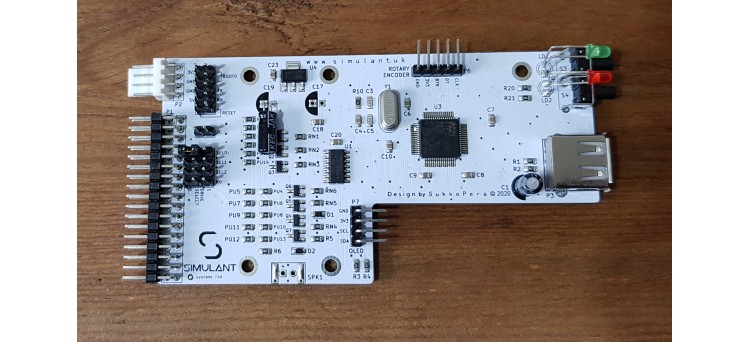I have been an avid MOS6502 fan since I built my first computer (Compukit UK101) in 1979, and I have wanted to build my own version for years, just for nostalgia!! I started with version 1 of the W65C02 SBC a couple of years ago built on breadboard. It worked perfectly and I have to give Grant Searle a mention for the inspiration to do it, coupled with the Cegmon code changes that made it possible as a serial connected version. Inevitably it became time to expand this SBC, so I commissioned a company to produce some PCBs for me. I ended up with some spare boards, and decided to sell them on via Tindie.


I still had the 5.25 Floppy Disks from my original kit from 1979 and thought it would be a great idea to hook something up to retrieve all the software I had written to them 40 odd years ago!!
I redesigned the Elektor Junior Floppy Disk Interface which itself was a copy of the OSI/UK101 original, and got some PCBs made. After completing the build of two boards, I connected my old trusty Teac 504 and attempted to boot from a master diskette 40 years old!!
After a few tick ticks from the drive, up booted OS65D3.0 perfectly!!
Again I had some boards left over so started to sell them on Tindie too.
Well the VDU PCB is finally here. The quality is excellent and I am really pleased at how well this complicated circuit has turned out. The Data bus is buffered as with all my boards using a 74LS245 Octal Bus Transceiver. Address decoding allows the 2kB Video ram to be accessible at any 2k block of memory. Mine is decoded to $D000 - $D7FF using the appropriate links. A 2716 Eprom is used as a character generator (The file for it is linked below) and uses the UK101 Character set. You may change it to whatever you want by programming a different Eprom. Internal clocking is derived from a 12Mhz Oscillator and scanning addresses are provided by 3x74LS393 counters, and CPU access is switched in and out using 3x74LS157s. 2x74123 Dual Retriggerable Multivibrators generate the Field and Line pulses while a 74LS165 chops up the 8 bit data and serializes it with the sync pulses to output to your TV or LCD AV input.
Please note!! I have found 74123s are preferable to 74LS123s in this circuit as they appear to be more stable. One of my valued customers wrote to me to let me know he used 74HCT123s and the display was rock steady.


I have also developed and produced a simple backplane PCB allowing up to 5 PCBs to share the Data and Address lines of the HobbyPCB 65C02 SBC. It has the same pinout as the SBC, and Floppy IF board so allows easy connection to each other. There is a 2k x 8 (32 rows by 64 columns) now available, and an extension RAM PCB (coming soon) which uses the same pin layout as the other boards so connecting is made very easy.
The backplane PCB has provision for a reset push-button, as the SBC's reset might be obscured by an additional board, an on/off switch. Space for an RS232 Dongle, and a 5V PSU connector.
This PCB allows the expansion of the 65C02 with a variety of add-on PCBs. They can be plugged in in any slot, there is no set position as each board picks up the Address, Data and Control Bus as needed.
After a lot of design and programming effort, the VIA board is now ready for use. You can use it purely as a Interface adapter, or add a PS2 socket to allow a PC keyboard to interface to the 65C02 SBC. Keyboard test routines are already programmed into the D/C/W/M version of the monitor @ $F000 , and the VIA is addressed at $9000 - $907F


A new PCB just launched is the 8k memory board. It can be addressed at any of the 8 x 8k Blocks in the 64K SBC Addressing range.
When I'm developing software for my SBC I am forever programming Eproms and then having to UV erase them to use them again. I have utilised an adapter PCB which allows me to program an EEprom in my programmer, and then fool the SBC into seeing it as an Eprom. To switch between the two is simply flicking a couple of DIL switches. I am now selling these adapters as a kit... 28C256->27C256 adapter PCB.


I hold a full Amateur Radio Licence (M0PHB) and naturally enjoy experimenting with the hobby. I have produced a small PCB which allows a Modified CM108 to interface with a Baofeng UV-5R and similar HTs

I have also had a lot of success using Simulant Gotek Floppy Emulators with the FD Interface, both singly, as a pair, and in conjunction with a real floppy drive too. Simulant Gotek Floppy Drive USB emulators are a real bargain at £24.99 direct from Simulant's web site. (They appear to be out of stock or not selling at the moment..Sep 2022)They come ready to accept 0.96 OLED displays, a rotary encoder and a speaker to give that authentic 'tick' 'tick' sound that is part of the nostalgia of floppy disks.
Once everything is connected and working all you will need is a standard USB drive (I use Sandisk Cruzers) with .HFE files for disk images. You can switch between images using the rotary control. OEM OS65D images and a tool to convert them into HFE format, are available from Mark's Ohio Scientific/Compukit UK101 Archive or Dave's OSI page.

